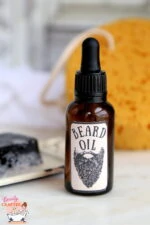DIY Magnesium Oil spray is a great way to supplement your body with this essential mineral. There are many benefits of topical magnesium, from keeping insomnia at bay to alleviating aches and pains.
Making your own magnesium chloride oil is not only an effective way to get magnesium, it is also a great money saver. Transdermal magnesium (applied topically to skin) actually absorbs better than orally ingested magnesium too!

Before we get to the recipe (and video) I have included for you below, I'll explain what magnesium oil is and it's many beneficial uses.
What is Magnesium Oil?
For starters, it is NOT actually oil. Magnesium oil is a mixture of Magnesium Chloride and water that creates an oily substance when applied to the skin. The best way of describing the concoction was to call it oil, so the name stuck!
The solution is just one of the ways you can supplement your daily magnesium intake. Yet, it has been proven in various studies that topical application such as with magnesium oil is the most effective way to absorb magnesium. This form of transdermal magnesium benefits our mind and body by absorbing the nutrients directly through our epidermis.
You will find that making your own magnesium oil is simple. It makes incorporating the mineral into other homemade magnesium products, such as balms or deodorant easy.
Magnesium Oil Benefits
Our bodies depend on sufficient magnesium levels and the right balance can do wonders for our health. Magnesium chloride oil can help your nerve and muscle functions, support a healthy pregnancy, and aid in maintaining blood pressure and blood sugar levels. Their are also significant beauty benefits of magnesium oil.
Magnesium for Sleep
Yes, magnesium spray can help you get a better night's sleep. To get restful sleep, your body and brain need to relax, which has a lot to do with the chemicals in your brain. Magnesium helps regulate melatonin and other neurotransmitters, which is directly linked to a person's sleep-wake cycle. Additionally, magnesium binds itself to GABA receptors which help calm down nerve activity.
The combination of these processes helps calm the mind and body into a restful state. This can be especially helpful for those suffering from restless leg syndrome. Transdermal application of magnesium spray prior to bedtime, certainly aids in getting a good night's rest!
Can you leave Magnesium Oil on Overnight?
Yes, you can leave it on overnight.
Some people find the magnesium solution itchy the first few times they use it. If it bothers you simply rinse it of after 20-30 minutes of transdermal absorption.
Magnesium for Pain
When it comes to pain, homemade magnesium oil can be beneficial on a number of areas for your body. It has been proven to help alleviate headaches and migraines, muscle cramps or stiffness, and reduce muscle spasms. Rub it on a sore muscle area to alleviate discomfort.
Magnesium oil can also help lower inflammation and joint pain while helping to speed up muscle recovery in your body.
Tip: Try mixing it in fractionated coconut oil along with frankincense and lavender. It makes an outstanding massage oil that will seep through skin and get right into muscle cells.
Magnesium Oil for Hair or Hair Loss
One symptom of magnesium deficiency is hair loss.
Magnesium chloride oil helps regulate calcium imbalances on your scalp. When you have calcium imbalance, calcium deposits in the scalp can cause blocks in your pores, which outwardly begin to show as hair loss or a slowdown in your hair growth.
When applied to your scalp, magnesium oil nourishes the tissues and aids in protein synthesis. It also helps block the calcium build up I mentioned, keeping the pores and hair follicles open, allowing for better hair growth.
I also suggest taking a multivitamin to ensure you have no other deficiencies and can process the topical magnesium properly for reduced hair loss. Vitamin D, A, E and Biotin supplements are helpful for attaining healthy hair. Women in particular should take an iron supplement, as iron deficiency often correlates with hair loss in the fairer sex.
Team the transdermal magnesium with essential oils for hair growth for even more effective results.
Dandruff and Graying
Application of magnesium solution to the scalp is also great for reducing dandruff problems.
If your hair loss or graying hair is due to a magnesium deficiency, you could see a reversal or stopping of these as you add magnesium oil into your health regime.
Magnesium Oil for Acne
Most people are magnesium deficient due to environmental and synthetic changes in the way food and water are processed. When magnesium is present in our bodies, it helps break apart different fats and oils that help reduce skin oiliness.
Magnesium also helps reduce skin inflammation, which greatly reduces the image and irritations caused by acne. Topical magnesium oil allows you to apply it directly to blemishes which helps reduce them quicker.
Magnesium for Deodorant
When present, magnesium can help regulate over 300 different biochemical functions in your body. Your body odor can actually be an indication of a mineral deficiency in your system.
Since the optimal magnesium absorption is through your skin, using a magnesium-based deodorant or magnesium oil as your deodorant will instantly help regulate and boost minerals and keep the stink away. Magnesium oil provides all-natural odor protection while helping you take advantage of all the other medical benefits of magnesium.
Magnesium Chloride vs. Epsom Salts (magnesium sulfate)
While an epsom salt bath can be quite relaxing, magnesium sulfate isn't the best method for magnesium supplementation. Magnesium chloride is a much more readily absorbed form of magnesium. If you really want to boost your levels of magnesium a magnesium chloride bath or daily spritzing with the oil is far more effective.
Side Effects of Topical Magnesium
There is actually no such thing as too much magnesium oil. After all, the sea is the best place to absorb magnesium and people go there all the time without side effects (remember that relaxed feeling you get from a day at the beach).
However, if your body is deficient and not used to the magnesium supplement, you may want to introduce it slowly. Test out your magnesium oil on a small patch of your forearm. Using topical magnesium for the first time can result in itching, stinging, or skin dryness. This is normal. Once you start applying the magnesium solution regularly to your skin, these symptoms should gradually disappear.
For reactions that include rashes, irritation, or prolonged skin redness, try diluting your oil with water until your body starts reacting more positively to the addition of topical magnesium.
When in doubt, always check with your physician or health care guide when introducing new supplements into your body.
How to Make Magnesium Oil Spray
This DIY magnesium oil recipe can bring you the right amount of supplemental magnesium to see all of the health benefits! Making it yourself from magnesium chloride flakes is easy and far less expensive than buying the oil ready made. You can make many bottles for the price of just one.
Double or triple up the batch and make a few spray bottles at once. They make thoughtful gifts, especially when a friend or loved one complains of difficulty with an issue this can help with. I've included a video of the process along with the printable recipe card.
Free Printable Labels
Make it clear what is in the bottles you make with these convenient ready to print labels. I made an them in both a simple black and white and a color aged look label. Simply print on card stock, cut out and adhere with glue. I used Tacky Glue
, which holds up pretty well, but washes off relatively easily if you chose to wash and use the bottle for something else later.
Print>> Magnesium Oil Labels - Aged
Print>> Magnesium Oil Labels - B&W

DIY Magnesium Oil
Ingredients
- ⅓ cup water
- ¼ cup magnesium chloride flakes
Supplies
- 4 oz. spray bottle
- card stock for labels
- Tacky Glue adhere labels
Instructions
- Bring water to a boil.
- Immediately add the magnesium flakes, turn off burner and stir until the flakes are fully dissolved.
- Allow to cool. Then use funnel to pour into the bottle for spraying.
- Print, cut out and adhere labels.


























Judy Rodriguez
Can you use distilled water for this?
Beauty Crafter
Yes, that would be even better. I simply use filtered water myself.